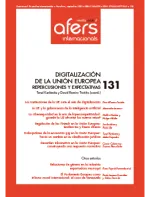European Union institutions’ strategy for facing the challenge of digitalisation

David Ramiro Troitiño, profesor titular de Relaciones Internacionales, TalTech-Tallinn University of Technology; titular de la Cátedra Jean Monnet de «La Europa Digital y su influencia en la integración futura» (2022-2025). david.troitino@taltech.ee. ORCID: https://orcid.org/0000-0002-0542-5724
The EU institutions – led by the Commission, Parliament and European Council, along with the Council of the EU – are determined to make this the union's “digital decade”. It is time for Europe to consolidate its digital development and set rules in line with its moral and cultural principles, instead of following those of external actors like China and the United States, as well as focussing on data, technology and infrastructure. This paper examines the EU’s digital development from the perspectives and positions of the abovementioned institutions, which show divergences, albeit within a common framework. Based on three theoretical currents (neofunctionalism, federalism and intergovernmentalism), it applies a critical perspective to analyse the impact (positive and/or negative) on European citizens of the institutions’ actions in this field.
Keywords: European Union, European Commission, European Parliament, European Council, Council of the EU, digitalisation, European integration, digital sovereignty, digital democratisation
How to cite this article: Ramiro Troitiño, David. «La estrategia de las instituciones de la Unión Europea ante el reto de digitalización». Revista CIDOB d’Afers Internacionals, n.º 131 (septiembre de 2022), p. 17-40. DOI: https://doi.org/10.24241/rcai.2022.131.2.17
Revista CIDOB d’Afers Internacionals n.º 131, p. 17-40
Quadrimestral (May-September 2022)
ISSN:1133-6595 | E-ISSN:2013-035X
DOI: https://doi.org/10.24241/rcai.2022.131.2.17
Reception date: 25.11.21 ; Acceptance date: 04.05.22
>> The full text articles are available in Spanish language, although in this issue some of them are also available in English language.